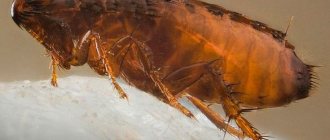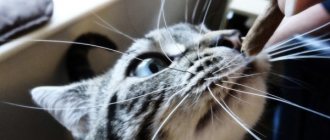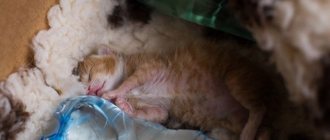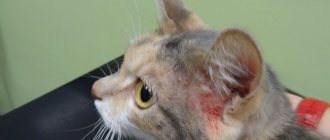If a cat licks its fur right down to its skin, this may be a sign of severe stress and the influence of other external factors. In veterinary medicine, this phenomenon is known as overgrooming.
If owners notice hairless patches on the belly, back, tail, hind legs and other parts of the body, the problem may be lice, fleas or small parasites.
Wounds that a cat scratches to the point of bleeding can lead to serious complications, including sepsis, if owners do not seek treatment for the underlying condition.
What to do if a cat licks its fur?
Cats are very clean, and licking their fur is a normal need. It cleanses the cat's fur of impurities and improves its thermoregulatory properties.
Our furry pets spend a lot of time grooming their fur every day, but if you notice that this grooming process has become obsessive, licking your cat's fur all the way down to the skin, it's important to find the cause.
Frequent intense licking is an alarming signal indicating the presence of any abnormalities or complications.
Careful use
Treating your pet with anti-flea drops
Manufacturers use insecticides of a certain dosage to make their products. A minimal amount is enough to eliminate fleas from a cat, but the dose remains safe for animals.
On a note!
The fact that it is recommended to drip in places inaccessible for licking is alarming: the area of the withers between the shoulder blades, along the spine. However, these recommendations relate more to the effectiveness of the product than to the safety of cats.
All modern drops for cats work the same way. Within 2 hours they are absorbed by the skin, localized in the hair follicles and sebaceous ducts. If the drops are licked off and do not have time to be absorbed, protection against fleas cannot be called complete.
Causes of Excessive Licking
The cat's tongue has spines that effectively clean the fur and skin. After eating, the cat must lick its face and ears. However, if the cat does not eat, does not sleep, but licks more and more each time, this is a sign that the animal has health problems:
The owner must monitor the behavior and condition of the animal. Excessive licking develops into a habit that persists even after the cause is eliminated. With timely treatment, the habit goes away spontaneously in about 20 days.
Communication between cat and owner
Our pets are loyal and open to communication. And if you want to find yourself a loyal friend who will simply be nearby and give you good emotions, get an animal. But now I would like to talk about an interesting phenomenon in the behavior of cats. You've probably seen a cat lick a person's hands or face. There are reasons for this:
- Your pet wants to show you love. While humans can express feelings through words or hugs, cats have other methods. This behavior is instinctive, and later we will look at why the pet exhibits it. You may already understand what we're talking about. But for now let's move on to the next point;
- Each animal has its own territory and “its own owner.” Therefore, with this behavior, the cat simply designates you as a member of the family. There is another option, when the pet does not perceive the owner as the main one, but, on the contrary, tries to clean it like a junior;
- You are in a bad mood and your pet wants to feel sorry for you. The cat also reacts to its stress. If you notice that your four-legged companion spends a long time cleaning himself, it could be stress. Or dermatological problems. But if an animal likes to lick a person, then she wants to comfort you.
No matter how rough your pet’s tongue is, you should always accept his affection and care. After all, this is how your pet expresses her feelings, wants to distract you from negative experiences, and feel sorry for you. There are other reasons, for example, the desire to get a treat. But even in this case, the animal shows sincere love for you. Why a cat likes to lick a person’s hands is a rather broad question. To understand your pet, you need to observe and communicate with him. Each animal has its own unique character. Yes, and a person influences the behavior of a pet. We talk about his actions, parenting methods, reactions to pranks and satisfaction of food needs.
There is no doubt that felines can be very smart and funny at the same time. And in their behavior you can find care for a person, their owner. Where there is a cat, there is an opportunity to console yourself and enjoy pleasant communication with the animal.
Don't leave your cat alone for long!
They do not need a full bowl of food, but human presence.
The cat sitter will take care of your pet, clean the litter box and make sure the bowls are clean.
Meet the cat
Why is overgrooming dangerous for cats?
Frequent and intense licking of a cat's fur can have serious consequences for its health.
The main signs of excessive grooming are:
- Baldness, hairless areas, bald spots on the body;
- Areas with sparse, brittle hair;
- Deterioration of coat condition;
- allergic symptoms;
- Scratches, ulcers, long-term non-healing wounds on the body;
- Drowsiness, apathy, or, conversely, constant anxiety.
Frequent licking can damage any area of the dermis that the cat can reach with its tongue. Lesions are most often observed on the abdomen, inner surface of the hind legs, front legs, flanks and sternum. The lesions are located symmetrically on the body.
By intensively licking the fur on its hind paw or tail, a cat can injure itself. If an infection gets into the wound, it will lead to acute inflammation in the deeper structures of the dermis. In severe cases, if the cat chews the skin, necrotic lesions may develop at the site of the injury.
Fleas, dewormers, viruses and bacteria can be acquired from fur by licking the skin. Excessive grooming can lead to disruption of the natural process of hair replacement, deterioration of the protective properties of the coat and dermis, which is especially dangerous for cats moving on the streets.
Stress
Unusual or even inappropriate behavior in a cat is not always a consequence of its poor physical health. Sometimes the reason has an emotional basis.
There are many situations that can cause stress in an animal:
- Relocation of a family member;
- Moving furniture;
- Loss of a pet's favorite toy;
- The appearance of another pet in the house and much more.
A cat's life is predictable and orderly, and everything that brings change is not always good for it.
Owners often try to impose their own rules on the cat.
But a freedom-loving cat may have its own ideas. You can't just rush the cat, it won't work. You may cause emotional distress. It is better to find mutual understanding with your pet.
Compromise is the only way out of the situation.
If the animal feels itching, it will actively lick the area. There is a clear pattern: a cat will lick wounds more thoroughly than scratch them. If the licking area is large, it means the cat is itching. In addition, attentive owners have noticed that when cats itch, they often lick their back, belly and other parts of the body.
Danger of droplets - theory
Effective flea treatments for cats contain insecticides. The substances belong to a low hazard class and, when used correctly, do not affect the well-being of the animal. However, the instructions below indicate that if there is an individual intolerance to the components, a number of side effects occur:
- loss of appetite, refusal to eat;
- excited state or apathy;
- drowsiness, insomnia;
- diarrhea;
- vomit;
- trembling throughout the body;
- convulsions;
- skin irritation;
- lacrimation;
- increased salivation;
- dilated pupils;
- violation of orientation in space.
It is this large list of side effects that makes you worry if your cat has taken flea drops. The whole difficulty lies in the fact that you can find out about the presence of individual intolerance in cats only after using antiparasitic drops.
Parasites can cause increased licking of fur
Both internal and external infections can make your cat want to lick the skin. In cases of parasitic infection, excessive licking is usually localized.
For example, an animal infested with fleas will lick and nibble on areas where there are blood vessels nearby: the belly and tail area. He will also scratch your neck and head in places where his mouth cannot reach.
If your cat is constantly licking under her tail, she may have worms, as their presence causes itching in the area.
Cats suffer from the following types of worms:
Worms attack various organs of the animal, including the liver, brain and lungs. However, regardless of where they live, they use the host's feces to spread.
Feces contain worm eggs, which secrete substances that cause itchy skin. As a result, the animal will actively lick the area under the tail, allowing new individuals to enter the body.
Check your pet's fur for skin parasites. Flea eggs (the insects themselves) or ticks, not yet swollen with blood and not visible in the fur, may be on parts of the body that attract your pet's attention. Look for signs of worms in your cat's feces.
If your cat constantly scratches and licks itself, but there are no fleas, small mites of the genus Sarcoptes scabiei may be the cause of the illness. These parasites can cause sarcoidosis, a disease characterized by red, scaly, and itchy skin. It can also happen that a cat licks its belly to the point of going bald due to demodex.
Demodex cati mites, like in humans, can coexist peacefully with a healthy person, manifesting themselves when the immune system is weakened. Foci of infection are located on the neck, head, ears and eyelids.
The presence of invisible parasites can be detected by a veterinarian by examining scrapings from the affected areas. Treatment depends on the type of infection. To combat skin parasites, a specialist may recommend an external remedy, for example, Bars Forte drops, which fight many arthropods. The drug kills larvae and adults by affecting their basic biological processes.
For diseases caused by helminths, it is convenient to use drugs in the form of dry food. Cats eat them more readily than tablets or emulsion - in this form they will easily spit out the medicine.
All types of medications are prescribed as part of treatment. Repeated use of the drug should be resumed after approximately 10 days. If helminths are detected, it is recommended to carry out preventive treatment of all inhabitants: people and animals.
Causes and symptoms
Healthy hair in cats is shiny, smooth, with strong hair follicles. With the development of disorders in the body, alopecia may occur. Its areas can be symmetrical, with complete or partial hair loss. Even an inexperienced owner will notice problems with a pet’s fur, since there will be large quantities of it around the apartment. You can try to determine the cause of the appearance of bald patches. With some diseases, cats begin to scratch the affected area. If the violation is more serious, the skin begins to peel off, ulcers and scabs appear on it. Sometimes seals form. The reasons why a cat's belly is going bald can be:
- allergic reaction to food or any of its components;
- prolonged stress state;
- mechanical damage;
- avitaminosis;
- hormonal disorders;
- liver pathologies;
- weakening of hair follicles;
- skin diseases of various types.
Allergy
Allergies appear in response to new foods, vitamins or medications, food additives, insect bites and other irritants. Symptoms: receding hairline, skin may become red or covered with small pimples, scratching. In most cases, symptoms go away if the allergen is removed from the diet.
Avitaminosis
Baldness in a pet can be caused by a lack of vitamins A, C and B or minerals. Alopecia areata is characteristic, when areas without hair have a round shape. They form extensive foci, merging together. The skin is bright pink.
Stress
Factors that caused stress could be moving, a new family member (child, another animal). At the same time, the cat begins to rapidly go bald, which is associated with severe shock and stress. When under stress, a cat usually tears its hairs on its own. Susceptible breeds: Siamese, Himalayan, Abyssinian. Their restored hair will be darker in color.
Hormonal disorders
If a cat's belly goes bald, it is often a sign of endocrine pathologies. They can be caused, for example, by neoplasms in any organ. Hormonal imbalance due to castration or sterilization can affect the thickness of the coat.
Skin diseases
Bald areas will be symmetrical. Their location is noted on the torso, limbs, sides and abdomen. Alopecia can occur at any age, and in this case it does not depend on gender. If the damage to the skin is caused by a fungus, it will become dry, with the formation of a rash and peeling. With trichophytosis or microsporia, areas without hair will have redness, scabs, scales and even wounds.
Problems not related to diseases
In some cases, excessive licking is not caused by any health problems.
This can be caused by various reasons, the most common of which are
- Stressful situations cause nervous tension, but in this case the cat’s behavior also changes. Her tail quivers, she shakes constantly, and her pupils are greatly dilated. Such conditions can occur during movement, with a sudden change in environment, or with aggressive behavior of other animals or owners.
- The desire to get rid of foreign odors, which most often manifests itself when a cat is stroked by a stranger or after returning from a walk in the fresh air.
- Fear of closed spaces, which may seem strange, but staying indoors for a long time has a negative effect on the cat’s psyche. In this position, he can lick himself to the point where serious wounds occur.
- Active grooming in the tail area when the female is in estrus, which is an attempt to clean the tail.
All pathological conditions should always be under observation, and the animal should not be deprived of attention.
Frequent and prolonged licking quickly leads to habituation, called excessive grooming. This is a mental disorder that is most common among purebred cats, but is also common in regular pets.
Prevention of baldness in cats
To ensure that your cat is not bothered by a disease such as baldness, the following preventive measures should be observed:
- feed the animal with balanced food;
- carry out vaccinations and preventive examinations on time;
- take care of your cat's fur;
- avoid stressful situations;
- exclude contact of a healthy animal with sick ones;
- Treat your cat for external parasites every 4-5 months.
Baldness in cats is common; it indicates a serious malfunction in the body. At the first signs of alopecia, show your animal to the veterinarian and begin treatment, do not start the disease, because it is easier to deal with it in the early stages.
Watch the video in which veterinarian Nadezhda will talk about the causes of alopecia in cats (baldness of cats) and treatment methods.
How to help a cat
To help your cat, you need to get to the root cause of the behavior problem. If the cause is a disease, the veterinarian will recommend symptomatic treatment with general and local drugs.
It is equally important to eliminate the factors contributing to the problem. Review your cat's diet, create optimal conditions and protect your cat from stress.
After treatment, bring your cat to the clinic several times a year for a comprehensive examination. In case of excessive care due to chronic pathology, relapses may occur.
Vitamin and mineral preparations, dietary supplements and animal shampoos with antiseptic and anti-inflammatory effects help restore the coat.
How to protect an animal from poisoning
No one will deny that it is easier to prevent a problem than to solve it. Therefore, you should take care in advance so that your pet does not harm itself.
Manufacturers recommend applying flea treatment to the withers area. The drops act the same, regardless of where they are applied, however, here they are most difficult to lick off. A pet simply will not be able to turn its head so as to reach the withers.
However, this does not mean that he will not have the opportunity to lick off the insecticide. A cat can become poisoned by licking the fur of another pet.
If there are several pets in the house, it is better to keep the animals separately, at least for the first two hours after treatment, until the product is absorbed.
If you encounter a nimble animal or the drops are applied unevenly, the pet will be able to reach distant areas on its fur and begin to lick off the insecticide.
To prevent this from happening, during treatment you can attach a collar to the fluffy’s neck, because of which the cat will no longer be able to turn his head and get to the poison.
Dangerous complications
Excessive grooming is a fairly serious deviation that can lead to negative consequences. Lack of timely and proper care can lead to:
- The formation of wool plugs in the cat's stomach and intestines, which leads to obstruction and accumulation of feces.
- The formation of non-healing wounds, ulcers or scratches, which are open gates for various infections. In severe cases, this can lead to the formation of necrotic lesions. To prevent this, wounds should be treated with antiseptic sprays and ointments and covered with bandages and plasters.
- The natural growth of the coat is disrupted and its protective functions deteriorate.
Excessive grooming is a pathology that requires a special approach and great responsibility. If it is caused by physiological health problems, treatment should be aimed at eliminating them. After recovery from the underlying disease, pathological licking will go away spontaneously.
Psychological problems will require more attention. Don't limit their freedom, play for at least 15-20 minutes a day, pet them regularly and show them love.
When moving, take familiar things with you, such as a cat house, scratching post or bed. In severe cases, veterinarians may prescribe medications to normalize the cat's condition.
Examination by a veterinarian and diagnosis
The effectiveness of treatment depends on an accurate diagnosis. As mentioned above, you should definitely contact a special clinic. Prescribing medications yourself is very dangerous. From such “treatment” the cat may lose all its fur.
At the veterinary hospital, your pet will be able to undergo the necessary examinations. One of the main tests is a trichogram. Thanks to it, they receive information about the condition of the coat, making the first conclusions about the causes of the disease.
To care for a cat, you need to know what a furminator is for, whether cats need clothes, everything about mating cats, how to choose a comfortable carrier, whether you need to sterilize a cat, how to trim a cat’s claws, how to make toys for a cat with your own hands, how to give birth to a cat how to make a scratching post.
Did you know? Smuggling cats from ancient Egypt was punishable by death.











